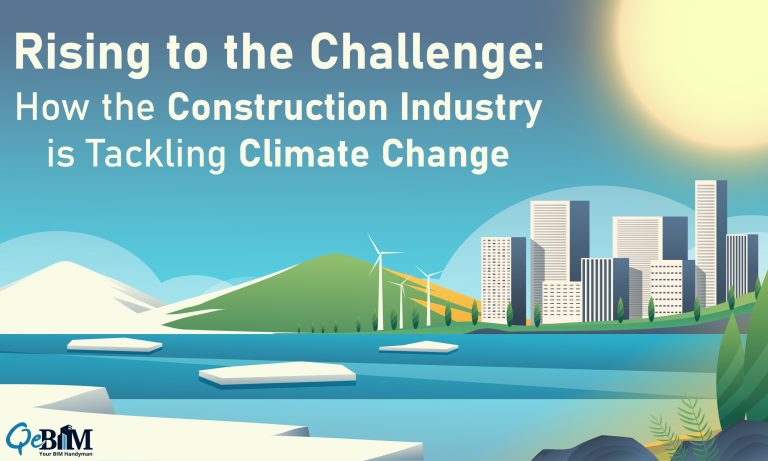Rising to the Challenge: How the Construction Industry is Tackling Climate Change

Introduction
In an era where the global community is increasingly grappling with the repercussions of climate change, industries across the spectrum are being forced to adapt and innovate. One such industry at the forefront of this transformation is construction. As the world witnesses the devastating impact of extreme weather events, rising sea levels, and depleting resources, the construction sector is stepping up to the plate, implementing Sustainability and Energy Analysis Services and resilient strategies to combat climate change.
The Climate Imperative
Urgent Action is required for the unavoidable reality of climate change. According to the Intergovernmental Panel on Climate Change (IPCC), global temperatures have risen by approximately 1.1 degrees Celsius since the late 19th century, primarily due to human activities emitting greenhouse gases. This rapid warming has contributed to intensified hurricanes, prolonged droughts, and increased flooding, wreaking havoc on communities worldwide.
The Construction Industry’s Carbon Footprint
The construction industry has historically been a significant contributor to greenhouse gas emissions, accounting for nearly 23% of global carbon dioxide emissions. Construction processes, transportation of materials, and energy-intensive operations are some of the major culprits. However, this industry’s substantial impact also positions it as a crucial player in the fight against climate change.
Transitioning Towards Net-Zero
Recognizing the urgency of the situation, the construction sector is making significant strides toward adopting sustainable practices and embracing a net-zero carbon future. One essential approach involves the broad implementation of renewable energy alternatives. Solar panels, wind turbines, and geothermal systems are becoming increasingly common on construction sites, reducing reliance on fossil fuels and decreasing carbon emissions.
A Shifting Landscape: Green Building Standards
Green building standards have emerged as a powerful tool for fostering sustainability in the construction industry. Prominent certifications like LEED (Leadership in Energy and Environmental Design) and BREEAM (Building Research Establishment Environmental Assessment Method) have risen to prominence, spurring the uptake of energy-efficient technologies, water preservation strategies, and ecologically conscious materials. The U.S. Green Building Council reports that LEED-certified buildings have collectively diverted over 80 million tons of waste from landfills and reduced greenhouse gas emissions by 38%.
Innovations in Material Science
The construction industry is witnessing a material revolution, with a shift towards low-carbon and recycled materials. For instance, the production of cement, a major carbon emitter, is being reimagined. Researchers are exploring alternatives such as fly ash, slag, and even carbon dioxide-infused concrete. These innovations not only reduce the carbon footprint of construction materials but also enhance the durability and resilience of structures.
Resilience in the Face of Climate Extremes
As the frequency and intensity of extreme weather events increase, the construction industry is embracing resilient design principles. Buildings and infrastructure are being engineered to withstand hurricanes, floods, and earthquakes. Elevated foundations, storm-resistant windows, and flexible designs that allow for expansion and contraction are becoming the norm. For instance, the Willis Tower in Chicago, USA, underwent a $500 million renovation, including the installation of new glass panels designed to withstand high winds and potential impacts.
Adapting Urban Planning
Climate-resilient urban planning is integral to the construction industry’s response to climate change. Cities are incorporating green spaces, permeable pavements, and sustainable drainage systems to mitigate flooding and improve air quality. For instance, Copenhagen, Denmark, is renowned for its sustainable urban design, featuring extensive cycling infrastructure and green roofs that contribute to temperature regulation and reduce energy consumption.
Challenges and Collaborative Solutions
While progress is evident, the construction industry still faces challenges in its journey toward climate resilience. Economic considerations, regulatory hurdles, and limited public awareness pose obstacles. However, collaborative efforts are underway. Governments, construction companies, architects, and engineers are partnering to develop innovative solutions incorporating 6D BIM Services. The World Green Building Council, for example, is uniting stakeholders to advocate for green building policies and practices worldwide.
Conclusion
As climate change continues to shape the world, the construction industry’s response has transitioned from an option to an imperative. With its significant carbon footprint and potential to influence sustainable development, this industry holds the key to a more resilient and climate-conscious future. Through the adoption of renewable energy, green building standards, material innovations, and resilient design, the construction sector is proving its commitment to mitigating climate change’s impact. As stakeholders collaborate and drive forward transformative solutions, the construction industry is poised to navigate the storm and emerge as a beacon of sustainability in an uncertain world.